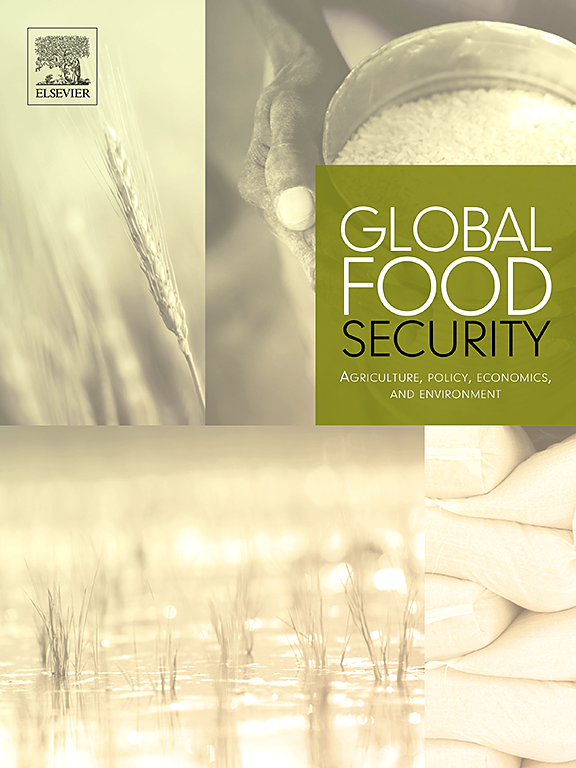衡量农业可持续性:重新审视可持续发展目标指标2.4.1及其替代指标
IF 9.6
1区 经济学
Q1 FOOD SCIENCE & TECHNOLOGY
Global Food Security-Agriculture Policy Economics and Environment
Pub Date : 2025-09-27
DOI:10.1016/j.gfs.2025.100887
引用次数: 0
摘要
可持续农业是可持续发展目标(SDG)的核心目标,可持续发展目标指标2.4.1的制定旨在评估国家和全球层面在可持续农业方面的进展。《全球粮食安全》杂志2023年发表的一篇文章强调了这一指标的优势和局限性。从那时起,尽管联合国粮食及农业组织做出了巨大努力,但数据可用性低一直是用可持续发展目标指标2.4.1衡量农业可持续性的一个挑战。为解决数据可用性低这一长期存在的问题,最引人注目的努力之一是制定一项由可持续发展目标指标2.4.1的托管机构粮农组织协调的代理指标。这篇前瞻性文章考察了代理的贡献和局限性,该代理使用七个子指标来评估农业可持续性的现状和趋势。该代理显著提高了数据的可用性,并支持趋势分析和子指标级别的比较。然而,仍然令人关切的是,它的计分方法含糊不清,对缺少数据的惩罚可能不成比例地影响到统计能力相对较弱的国家。本文提出了改进代理的设计和实施的建议,特别是处理缺失数据的替代方法,以及在更多地考虑国家统计能力的情况下更广泛地参与其进一步更新。它还强调了未来研究跨可持续发展目标相互作用和地方知识整合的机会。虽然代理提供了一个切实可行的临时解决方案,但继续努力加强国家统计系统对于充分实现可持续发展目标指标2.4.1的意图仍然至关重要。本文章由计算机程序翻译,如有差异,请以英文原文为准。
Measuring agricultural sustainability: Revisiting Sustainable Development Goal Indicator 2.4.1 and its proxy
Sustainable agriculture is a central target of the Sustainable Development Goals (SDGs), with the development of SDG Indicator 2.4.1 to assess the progress towards sustainable agriculture at national and global levels. A 2023 article published in Global Food Security highlighted both the strengths and limitations of this indicator. Since then, despite the tremendous efforts from the Food and Agriculture Organization of the United Nations, the low availability of data has been a challenge for measuring agricultural sustainability with SDG Indicator 2.4.1.
One of the most notable efforts to address the persistent issue of low data availability is the development of a proxy indicator coordinated by FAO, the custodian agency of SDG Indicator 2.4.1. This perspective article examines the contributions and limitations of the proxy, which uses seven sub-indicators to assess both current status and trends in agricultural sustainability. The proxy significantly improves data availability and enables trend analysis and sub-indicator-level comparisons. However, concerns remain about the ambiguity in its scoring methodology and the penalization of missing data, which may disproportionately affect countries with relatively weaker statistical capacity. This article offers suggestions for improving the proxy's design and implementation, especially alternative methods of treating missing data and wider participation in its further updates with more consideration of national statistical capacity. It also highlights opportunities for future research on cross-SDG interactions and the integration of local knowledge. While the proxy offers a practical interim solution, continued efforts to strengthen national statistical systems remain essential for fully realizing the intent of SDG Indicator 2.4.1.
求助全文
通过发布文献求助,成功后即可免费获取论文全文。
去求助
来源期刊

Global Food Security-Agriculture Policy Economics and Environment
FOOD SCIENCE & TECHNOLOGY-
CiteScore
20.90
自引率
3.40%
发文量
69
期刊介绍:
Global Food Security plays a vital role in addressing food security challenges from local to global levels. To secure food systems, it emphasizes multifaceted actions considering technological, biophysical, institutional, economic, social, and political factors. The goal is to foster food systems that meet nutritional needs, preserve the environment, support livelihoods, tackle climate change, and diminish inequalities. This journal serves as a platform for researchers, policymakers, and practitioners to access and engage with recent, diverse research and perspectives on achieving sustainable food security globally. It aspires to be an internationally recognized resource presenting cutting-edge insights in an accessible manner to a broad audience.
 求助内容:
求助内容: 应助结果提醒方式:
应助结果提醒方式:


